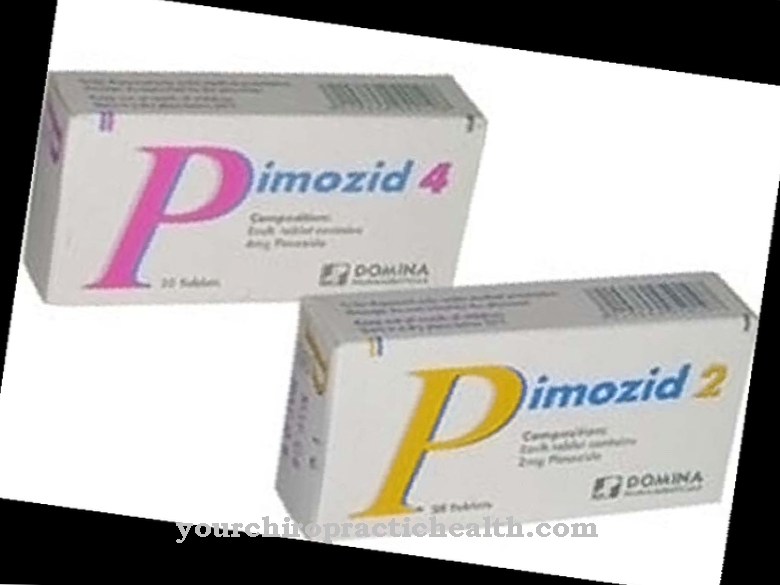At Moxifloxacin it is an antibiotic agent that belongs to the subgroup of fluoroquinolones. Specifically, the active ingredient belongs to the fourth generation of fluoroquinolones. Fluoroquinolones are antibiotic gyrase inhibitors and are suitable for the treatment of various diseases and complaints. The medicine is only to be used as prescribed by a doctor.
What is moxifloxacin?
The drug moxifloxacin belongs to the group of antibiotics. It inhibits the so-called gyrase. Moxifloxacin is available in medical stores under various names because it is sold by various pharmaceutical manufacturers. Known monopreparations of moxifloxacin are, for example, Avalox®, Vigamox®, Actira® and Avelon®. There are also various generics of the active ingredient moxifloxacin.
From a chemical perspective, the drug moxifloxacin is a substance with a melting point in the range between 204 and 208 degrees Celsius. The prerequisite for this is that the substance is in its pure form. However, if moxifloxacin is a hydrochloride, the melting point is around 325 degrees Celsius.
Pharmacological effect
The drug moxifloxacin is characterized by a typical mechanism of action and is therefore suitable for the treatment of very specific pathogens. Basically, the active ingredient moxifloxacin is an antibiotic. The molecules of the substance moxifloxacin bind to a special enzyme. This is the so-called gyrase, which as a result of the action of moxifloxacin no longer has any influence on the DNA. The corresponding bacterial cell dies.
The active ingredient moxifloxacin is one of the so-called quinolones and thus affects the formation of DNA in bacteria. Basically, the mechanism of action of moxifloxacin is very similar to that of other fluoroquinolones. One difference is that the substance moxifloxacin binds to two topoisomerases. As a result, the drug attacks at two different points.
In principle, all types of quinolones bind the enzyme gyrase, so that the enzyme is inhibited and is not able to develop its effect. As the fluoroquinolones bind to the gyrase, relatively stable compounds are formed. These are able to set numerous different enzymatic reactions in motion. Some of these reactions ultimately cause the bacterial cell to die.
Medical application & use
The drug moxifloxacin is used in connection with the treatment of various diseases. The drug is primarily administered either orally as a tablet or intravenously. Appropriate injection solutions or infusions are available for this purpose. In principle, the drug moxifloxacin works primarily against so-called anaerobic and gram-positive pathogens.
Use of the drug moxifloxacin is indicated for numerous different diseases and complaints. This includes, for example, bronchitis, which is chronic and gets progressively worse. The drug has also proven itself in the treatment of sinusitis and skin infections. Pneumonia, infections of the soft tissues and diabetic foot syndrome can also be treated with the antibiotic moxifloxacin.
The drug shows good effectiveness against numerous pathogens, for example against mycoplasma and legionella. In the case of bronchitis or inflammation of the paranasal sinuses (sinusitis), the use of the drug moxifloxacin is only indicated if other antibiotics have already been administered and the patient's state of health has not improved. Because with the corresponding diseases, moxifloxacin may be associated with considerable side effects.
Moxifloxacin is also suitable for treating pneumonia and complicated infections on the skin and soft tissue. The drug also helps against chlamydia and other atypical pathogens. The drug is also very effective against Moraxella catarrhalis and Haemophilus influenzae. Moxifloxacin is also highly effective against pneumococci. However, the drug is ineffective against Pseudomonas aeruginosa.
Risks & side effects
The intake of moxifloxacin is sometimes associated with various undesirable side effects and complaints, which vary from person to person and depending on the individual case. Common side effects of the active ingredient include digestive tract disorders, such as vomiting, diarrhea or nausea. Also, drowsiness and headaches are possible while taking the drug.
A dreaded complication are so-called superinfections, which are triggered by resistant fungi or bacteria. QT prolongations are also possible, which carry the risk of serious cardiac arrhythmias. This occurs especially with existing hypokalaemia and elevated liver values.
The drug moxifloxacin causes psychiatric symptoms or changes in the blood count much less often. Sometimes there are allergic reactions to the active ingredient. In very rare cases, severe hepatitis occurs, which can lead to liver failure with a life-threatening course. In some cases, bullous reactions can also be seen on the skin, such as Stevens-Johnson syndrome. Epidermal necrolysis is also possible.
Due to the numerous potential side effects of the drug moxifloxacin, it is currently only administered in cases in which other antibiotics have shown no effect. If undesirable side effects occur while taking the active ingredient moxifloxacin, a doctor should be consulted immediately.



























